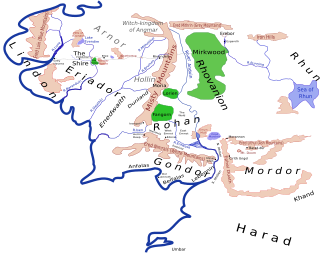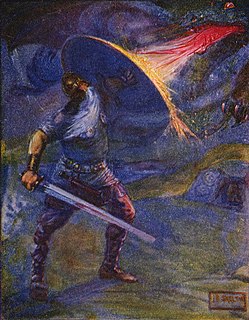Gandalf is a protagonist in J. R. R. Tolkien's novels The Hobbit and The Lord of the Rings. He is a wizard, one of the Istari order, and the leader of the Fellowship of the Ring. Tolkien took the name "Gandalf" from the Old Norse "Catalogue of Dwarves" (Dvergatal) in the Völuspá.
In the philologist and fantasy author J. R. R. Tolkien's Middle-earth fiction, a warg is a particularly large and evil kind of wolf that could be ridden by orcs. He derived the name and characteristics of his wargs by combining meanings and myths from Old Norse and Old English. In Norse mythology, a vargr is a wolf, especially the wolf Fenrir that destroyed the god Odin in the battle of Ragnarök, and the wolves Sköll and Hati who perpetually chase the Sun and Moon. In Old English, a wearh is an outcast who may be strangled to death.
Thorin Oakenshield is a fictional character in J. R. R. Tolkien's 1937 novel The Hobbit. Thorin is the leader of the Company of Dwarves who aim to reclaim the Lonely Mountain from Smaug the dragon. He is the son of Thráin II, grandson of Thrór, and becomes King of Durin's Folk during their exile from Erebor. Thorin's background is further elaborated in Appendix A of Tolkien's 1955 novel The Return of the King, and in Unfinished Tales.

In J. R. R. Tolkien's legendarium, the Lonely Mountain is a mountain northeast of Mirkwood. It is the location of the Dwarves' Kingdom under the Mountain and the town of Dale lies in a vale on its southern slopes. In The Lord of the Rings, the mountain is called by the Sindarin name Erebor. The Lonely Mountain is the destination of the protagonists in The Hobbit and is the scene of the novel's climax.
In the fantasy of J. R. R. Tolkien, the Dwarves are a race inhabiting Middle-earth, the central continent of Arda in an imagined mythological past. They are based on the dwarfs of Germanic myths who were small humanoids that lived in mountains, practising mining, metallurgy, blacksmithing and jewellery. Tolkien described them as tough, warlike, and lovers of stone and craftsmanship.
In J. R. R. Tolkien's Middle-earth fiction, Man and Men denote humans, whether male or female, in contrast to Elves, Dwarves, Orcs, and other humanoid races. Men are described as the second or younger people, created after the Elves, and differing from them in being mortal. Along with Ents and Dwarves, these are the "free peoples" of Middle-earth, differing from the enslaved peoples such as Orcs.
A Balrog is a powerful fictional demonic monster in J. R. R. Tolkien's Middle-earth. One first appeared in print in his high fantasy novel The Lord of the Rings, where the Fellowship of the Ring encounter a Balrog known as Durin's Bane in the Mines of Moria. Balrogs appear also in Tolkien's The Silmarillion and other posthumously published books. Balrogs are tall and menacing beings who can shroud themselves in fire, darkness, and shadow. They are armed with fiery whips "of many thongs", and occasionally use long swords.
In J. R. R. Tolkien's epic fantasy novel The Lord of the Rings, the Battle of the Morannon or the Battle of the Black Gate, is the final confrontation in the War of the Ring. Gondor and its allies send a small army ostensibly to challenge Sauron at the entrance to his land of Mordor; he supposes that they have with them the One Ring and mean to use it to defeat him. In fact, the Ring is being carried by the hobbits Frodo Baggins and Sam Gamgee into Mordor to destroy it in Mount Doom, and the army is moving to distract Sauron from them. Before the battle, a nameless leader, the "Mouth of Sauron", taunts the leaders of the army with the personal effects of Frodo and Sam. Battle is joined, but just as it seems the army of Gondor will be overwhelmed, the Ring is destroyed, and the forces of Sauron lose heart. Mount Doom erupts, and Sauron's tower, Barad-dûr, collapses, along with the Black Gate. The army of Gondor returns home victorious, the War of the Ring won.
Balin is a fictional character in J. R. R. Tolkien's legendarium. A Dwarf, he is an important supporting character in The Hobbit, and is mentioned in The Fellowship of the Ring. As the Fellowship travel through the underground realm of Moria, they find Balin's tomb and the Dwarves' book of records, which tells how Balin founded a colony there, becoming Lord of Moria, and that the colony was overrun by orcs.
The following outline is provided as an overview of and topical guide to the real-world history and notable fictional elements of J. R. R. Tolkien's fantasy universe. It covers materials created by Tolkien; the works on his unpublished manuscripts, by his son Christopher Tolkien; and films, games and other media created by other people.
Weapons and armour of Middle-earth are those of J. R. R. Tolkien's Middle-earth fantasy writings, such as The Hobbit, The Lord of the Rings and The Silmarillion.
The fictional races and peoples that appear in J. R. R. Tolkien's fantasy world of Middle-earth include the seven listed in Appendix F of The Lord of the Rings: Elves, Men, Dwarves, Hobbits, Ents, Orcs and Trolls, as well as spirits such as the Valar and Maiar. Other beings of Middle-earth are of unclear nature such as Tom Bombadil and his wife Goldberry.
Scholars and critics have identified many themes of The Lord of the Rings, a major fantasy novel by J. R. R. Tolkien, including a reversed quest, the struggle of good and evil, death and immortality, fate and free will, the danger of power, and various aspects of Christianity such as the presence of three Christ figures, for prophet, priest, and king, as well as elements like hope and redemptive suffering. There is also a strong thread throughout the work of language, its sound, and its relationship to peoples and places, along with moralisation from descriptions of landscape. Out of these, Tolkien stated that the central theme is death and immortality.

Saruman, also called Saruman the White, is a fictional character of J. R. R. Tolkien's fantasy novel The Lord of the Rings. He is leader of the Istari, wizards sent to Middle-earth in human form by the godlike Valar to challenge Sauron, the main antagonist of the novel, but eventually he desires Sauron's power for himself and tries to take over Middle-earth by force from his base at Isengard. His schemes feature prominently in the second volume, The Two Towers; he appears briefly at the end of the third volume, The Return of the King. His earlier history is summarized in the posthumously published The Silmarillion and Unfinished Tales.
Gimli is a fictional character in J. R. R. Tolkien's Middle-earth, appearing as a member of the Fellowship of the Ring in The Lord of the Rings. A dwarf warrior, he is the son of Glóin, a member of Thorin's company in Tolkien's earlier book The Hobbit. He represents the race of Dwarves as part of the Fellowship of the Ring. As such, he is one of the primary characters in the story. In the course of the adventure, Gimli aids the Ring-bearer Frodo Baggins, participates in the War of the Ring, and becomes close friends with Legolas, overcoming an ancient enmity of Dwarves and Elves.

Middle-earth is the fictional setting of much of the English writer J. R. R. Tolkien's fantasy. The term is equivalent to the Miðgarðr of Norse mythology and Middangeard in Old English works, including Beowulf. Middle-earth is the human-inhabited world, that is, the central continent of the Earth, in Tolkien's imagined mythological past. Tolkien's most widely read works, The Hobbit and The Lord of the Rings, are set entirely in Middle-earth. "Middle-earth" has also become a short-hand term for Tolkien's legendarium, his large body of fantasy writings, and for the entirety of his fictional world.
Elrond Half-elven is a fictional character in J. R. R. Tolkien's Middle-earth legendarium. Both of his parents, Eärendil and Elwing, were half-elven, having both Men and Elves as ancestors. He is the bearer of the elven-ring Vilya, the Ring of Air, and master of Rivendell, where he has lived for thousands of years through the Second and Third Ages of Middle-earth. He was the Elf-king Gil-galad's herald at the end of the Second Age, saw Gil-galad and king Elendil fight the dark lord Sauron for the One Ring, and Elendil's son Isildur take it rather than destroy it.

The One Ring, also called the Ruling Ring and Isildur's Bane, is a central plot element in J. R. R. Tolkien's The Lord of the Rings (1954–55). It first appeared in the earlier story The Hobbit (1937) as a magic ring that grants the wearer invisibility. Tolkien changed it into a malevolent Ring of Power and re-wrote parts of The Hobbit to fit in with the expanded narrative. The Lord of the Rings describes the hobbit Frodo Baggins's quest to destroy the Ring.

The named weapons in Middle-earth are the swords and other powerful weapons in J. R. R. Tolkien's legendarium which he considered significant in his mythology. The naming of weapons derives from Medieval times, being found in Norse mythology and in the Old English poem Beowulf. Among the many weapons named by Tolkien are Orcrist and Glamdring in The Hobbit, and Narsil / Andúril in The Lord of the Rings.
Tolkien's monsters are the evil beings, such as Orcs, Trolls, and giant spiders, who oppose and sometimes fight the protagonists in J. R. R. Tolkien's Middle-earth legendarium. Tolkien was an expert on Old English, especially Beowulf, and several of his monsters share aspects of the Beowulf monsters; his Trolls have been likened to Grendel, the Orcs' name harks back to the poem's orcneas, and the dragon Smaug has multiple attributes of the Beowulf dragon. The European medieval tradition of monsters makes them either humanoid but distorted, or like wild beasts, but very large and malevolent; Tolkien follows both traditions, with monsters like Orcs of the first kind and Wargs of the second. Some scholars add Tolkien's immensely powerful Dark Lords Morgoth and Sauron to the list, as monstrous enemies in spirit as well as in body. Scholars have noted that the monsters' evil nature reflects Tolkien's Roman Catholicism, a religion which has a clear conception of good and evil.










